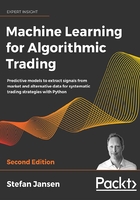
Summary
In this chapter, we covered the important topic of portfolio management, which involves the combination of investment positions with the objective of managing risk-return trade-offs. We introduced pyfolio to compute and visualize key risk and return metrics, as well as to compare the performance of various algorithms.
We saw how important accurate predictions are for optimizing portfolio weights and maximizing persification benefits. We also explored how machine learning can facilitate more effective portfolio construction by learning hierarchical relationships from the asset-returns covariance matrix.
We will now move on to the second part of this book, which focuses on the use of machine learning models. These models will produce more accurate predictions by making more effective use of more perse information. They do this to capture more complex patterns than the simpler alpha factors that were most prominent so far.
We will begin by training, testing, and tuning linear models for regression and classification using cross-validation to achieve robust out-of-sample performance. We will also embed these models within the framework for defining and backtesting algorithmic trading strategies, which we covered in the previous two chapters.